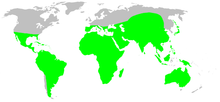Tree trunk spider
| Tree trunk spider Temporal range:
| |
|---|---|

| |
| Male Hersilia okinawaensis | |
| Scientific classification | |
| Domain: | Eukaryota |
| Kingdom: | Animalia |
| Phylum: | Arthropoda |
| Subphylum: | Chelicerata |
| Class: | Arachnida |
| Order: | Araneae |
| Infraorder: | Araneomorphae |
| Family: | Hersiliidae Thorell, 1869 |
| Diversity | |
| 16 genera, 206 species | |

| |
Hersiliidae is a tropical and subtropical family of spiders first described by Tamerlan Thorell in 1869,[1] which are commonly known as tree trunk spiders. They have two prominent spinnerets that are almost as long as their abdomen, earning them another nickname, the "two-tailed spiders". They range in size from 10 to 18 mm (0.4 to 0.7 in) long. Rather than using a web that captures prey directly, they lay a light coating of threads over an area of tree bark and wait for an insect to stray onto the patch. When this happens, they encircle their spinnerets around their prey while casting silk on it. When the insect is immobilized, they can bite it through the shroud.
Diversity[edit]
Hersiliidae is an entelegyne family (characterized primarily by the nature of the female genital system), and together with the family Oecobiidae traditionally formed the superfamily Oecobioidea.[2] The family consists of about 206 species divided into sixteen genera.[3] It has a global distribution in tropical and subtropical regions, with only a few species being found north of the 40°N parallel. All members are ecribellate (lack the cribella or perforated plates which produce multiple, exceptionally fine strands of silk) and are recognizable by the pair of exceptionally long spinnerets set at the tip of the abdomen.[2] They have eight eyes, set in two curved rows. They are small to medium-sized spiders and are active day and night. They are very well camouflaged when stationary on the trunk of a tree and aligned with the bark markings.[4]
Genera[edit]
As of April 2019[update], the World Spider Catalog accepts the following genera:[3]
- Bastanius Mirshamsi, Zamani & Marusik, 2016 — Iran
- Deltshevia Marusik & Fet, 2009 — Turkmenistan, Kazakhstan, Uzbekistan
- Duninia Marusik & Fet, 2009 — Turkmenistan, Iran
- Hersilia Audouin, 1826 — Africa, Asia, Oceania
- Hersiliola Thorell, 1870 — Asia, Africa, Spain
- Iviraiva Rheims & Brescovit, 2004 — South America
- Murricia Simon, 1882 — Asia, Africa
- Neotama Baehr & Baehr, 1993 — South Africa, South America, North America, El Salvador, Asia
- Ovtsharenkoia Marusik & Fet, 2009 — Central Asia
- Prima Foord, 2008 — Madagascar
- Promurricia Baehr & Baehr, 1993 — Sri Lanka
- Tama Simon, 1882 — Spain, Portugal, Algeria
- Tamopsis Baehr & Baehr, 1987 — Australia, Indonesia, Papua New Guinea
- Tyrotama Foord & Dippenaar-Schoeman, 2005 — Africa
- Yabisi Rheims & Brescovit, 2004 — Dominican Republic, United States, Cuba
- Ypypuera Rheims & Brescovit, 2004 — South America
Extinct genera[edit]
- †Burmesiola Wunderlich 2011 Burmese amber, Myanmar, Cenomanian
- †Fictotama Petrunkevitch 1963 Dominican amber, Miocene
- †Gerdia Menge 1869 Baltic amber, Eocene
- †Gerdiopsis Wunderlich 2004 Baltic amber, Eocene
- †Gerdiorum Wunderlich 2004 Baltic amber, Eocene
Gallery[edit]
-
Injecting venom through the shroud
-
Fully immobilized the cicada
See also[edit]
References[edit]
- ^ Thorell, T. (1869). "On European spiders". Nova Acta Regiae Societatis Scientiarum Upsaliensis. 3 (7): 109–242.
- ^ a b Stoev, Pavel; Dunlop, Jason; Lazarov, Stoyan (2009). A life caught in a spider's web. PenSoft Publishers. p. 76. ISBN 978-954-642-502-7.
- ^ a b "Family: Hersiliidae Thorell, 1869". World Spider Catalog. Natural History Museum Bern. Retrieved 2019-04-22.
- ^ Whyte, Robert; Anderson, Greg (2017). A Field Guide to Spiders of Australia. Csiro Publishing. p. 157. ISBN 978-0-643-10708-3.
External links[edit]
- Order Araneae - Spiders at BugGuide (including images)
- Hersilia sp. Hersiliidae—Image



